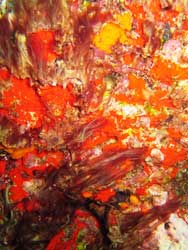Panama prospecting - going for the green
May - June, 2009 | Volume 8, Issue 3
This native San Franciscan is a prospector, but don't confuse him with the rapacious plunderers of 1849.
What Dr. William Gerwick has been doing for a decade is "mining" the pristine waters off the coast of Panama for potential cancer drugs. At the same time, he and his team of researchers are helping Panamanians preserve one of the world's last unspoiled refuges for plant and marine life.

Photo by Kim Diver
The organism that produces coibamide
The medicinal gold they are seeking is green. Actually blue-green, as in the algae species Leptolyngbya sp. that is being analyzed by the Fogarty-run International Cooperative Biodiversity Group (ICBG) working on and near Coiba Island. The island lies off the Pacific Coast of Panama, cut off from the outside world just as was the prison that was its main business for much of the 20th century.
Gerwick, an oceanographer at the University of California, and Kerry McPhail, a former postdoctoral student of his from Oregon State University and now a National Cancer Institute grantee, discovered the potent new cancer toxin last year.
After scooping up the algae and extracting its oil, they were left with what Gerwick calls "green goo" that turned out to contain "phenomenal anticancer activity." In recognition of its origin, they named the compound coibamide. "While we don't have all of the details worked out yet, the pathways involved are becoming clear that coibamide has a novel mechanism of action," Gerwick says.
Although the molecule still must be cultured and synthesized in the lab, Fogarty's Dr. Josh Rosenthal, the ICBG program director, says, "Coibamide is a terrific example of how drug discovery research can support scientific and economic development, which can in turn support conservation."
Gerwick, rather than considering himself a bioprospector, says, "We are builders, not destroyers. We are attaching value to these life forms" for the benefit of science as well as the economy and biodiversity of Panama.
The Panama program has helped build the country's research infrastructure and economy by training 90 Panamanian and U.S. scientists, employing local lab technicians and, just as valuable, helping get Coiba added to the roster of UNESCO World Heritage Sites.
To view Adobe PDF files,
download current, free accessible plug-ins from Adobe's website.
Related Fogarty Programs
Related World Regions / Countries